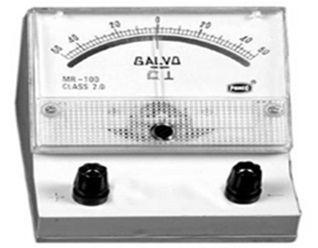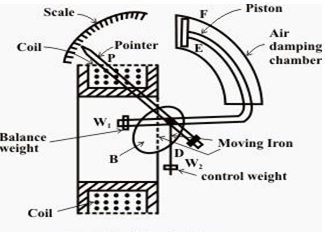An ammeter is a combination of words ampere and meter or we can say an instrument that measures ampere (current). Electrical quantities are to be continuously monitored being very dynamic. Real-time monitoring of current is of utmost importance as the current is the most flexible/dynamic electrical quantity. An Ammeter which facilitates monitoring of current is a basic instrument in electrical engineering. Approximately eighty percent of electrical breakdowns are caused due to unmonitored/uncontrolled flow of current, therefore monitoring of current cannot be underemphasized. The energy efficiency/ star rating of various electrical equipment has increased the importance of monitoring current along with other parameters. As ammeters can be chosen from a very wide range and types depending on their suitability, here we shall restrict ourselves to basic and commonly used ones.
What is Ammeter?
Definition: An ammeter is an instrument which is used to measure electric current in amperes flowing in a circuit. If the current is very less, we have to measure it in milliamperes or microamperes then we call it a milli/microampere meter. The symbolic representation of ammeter is represented as under. This symbol is common in all standards.
Ammeter Diagram
As the operating principle/working principle of an ammeter depends on the type of current AC / DC to be measured its circuit diagram / operating principle also changes accordingly.

Ammeter
In DC measurements the basic instrument is a galvanometer which is converted into an ammeter or voltmeter with some modifications. Now, let us study galvanometer, and then we will see how it can be converted into an ammeter.
A galvanometer is an electromagnetic instrument that has a permanent magnet the poles of which are in shoehorn shape, it has a soft iron core around which a thin coil is wound. The coil carries the current which is to be measured and is free to move on pivot till it is restrained by a restraining spring. The induction between the permanent magnet and the magnetic field created by the coil produces a rotating torque proportional to the current flowing through the coil. A pointer is attached to the coil which gives the reading on the meter. This is known as a moving-coil galvanometer/ammeter. These meters are suitable only for the unidirectional flow of current (DC).

Ammeter Construction
Working of Ammeter
Externally a galvanometer has in and out terminal with a uniform scale and a pointer, just below the scale a mirror strip in arch shape is provided for removing the parallax error while taking the reading.
Since these meters can allow only a small quantity of current to pass through it, we have to provide an alternative route to the current and calibrate the meter in such a way that the reading indicated is indicative of the total current. This is done by providing a suitable ammeter shunt across the meter. As an example, let’s say we have to measure 100 Amps (amperes)in a circuit and we have a galvanometer that gives full-scale deflection (0-100) when the voltage across the galvanometer terminals is 75 mv. Therefore, if we connect a 100 Amp. 75 mv shunt across the galvanometer terminals we get a full-scale deflection when the current is 100 Amps. The voltage drop will always be proportional to current. By connecting a suitable shunt, we have converted a galvanometer into an ammeter.

Working of Ammeter
Where: i = ig +(i-ig)
‘Ig’ is proportional to (i-ig)*S ie. voltage drop across the shunt.
‘S ‘is the resistance of the shunt.
Now, let us consider the measurement of AC current where we know reversal of current takes place and a moving coil type of instrument will start hunting under such conditions. Therefore, we use a moving iron type of instrument which works on the principle of attraction/repulsion. The force of attraction is proportional to the strength of the magnet which in turn is proportional to the amount of current flowing through the coil responsible magnetic field. These meters can be used for both AC and DC measurements and have a cramped scale. Here in order to reduce the current flowing through the meter we have to use current transformers of suitable current ratio with the secondary current of either 5 amp. or 1 amp.

Attraction Type
Classification/Types of Ammeter
Ammeters commonly used can be classified on various bases as under:
Operating Principle
- Moving coil type (Also known as a permanent magnet moving coil, PMMC)
- Moving iron type (attraction/repulsion)
- Electro dynamo type
- Rectifier type
- Digital type
Dial Type
- 90 Degree squire dial
- 270 Degree round dial
Scale Type
- Uniform
- Cramped
Input Supply
- Direct current
- Alternating current
Application
- Direct reading type
- Shunt/current transformer type.
While the operating principle/working of moving coil and moving iron has already been explained in detail, let now see the other types.
Electro Dynamo Type
These meters work on a principle that is a combination of moving coil and moving iron. And are suitable for measuring both AC and DC. In these meters, we have two coils one responsible for magnetizing and the other producing the torque. The same current is made to flow through both the coils so that the reversal of current does not affect the performance.
Rectifier Type
These types are basically DC meters which are used to measure AC after rectification. Change in frequency does not affect the performance of these meters.
Digital Type
These are electronic meters based on digital technology and are very commonly used these days.
Please refer to this link for Ammeter MCQs.
Advantages/Disadvantages
The advantages/disadvantages of ammeter types include the following.
Advantages of permanent magnet moving coil instruments
- The permanent magnet moving coil instruments have low power consumption.
- These meters are uniform scale meters which can be 90 degrees or 270 degrees. And have good accuracy.
- Have good torque to weight ratio.
- Provide good damping (can quickly come to a stable reading)
- It is not affected by the stray magnetic field, which is common in the lab/workshop environment.
Disadvantages
- These meters can only be used for direct current supply. For measuring alternating current, we can do it only after rectification.
- Over a period of time, the permanent magnet may lose magnetism introducing some error in reading.
- These meters are costly compared to moving iron type.
Advantages of moving iron instruments
- These instruments can measure both AC and DC currents.
- Are robust and cost-effective if compared to PMMC meters.
Disadvantages
- Have a cramped or nonlinear scale.
- Accuracy levels are lower than PMMC meters.
- Power consumption and losses are high.
- It has to be kept in a vertical position as it works on gravity control.
Advantages of Electro Dynamo type ammeters
- These meters have low iron losses.
- It can be used for both AC and DC.
- They are very accurate and give RMS values which no effect on the waveform.
Disadvantages
- These meters do not have a uniform scale.
- They are bulky and are not sensitive to low values.
- They are expensive compared to the PMMC and MI instruments.
Advantages of rectifier type are
- These meters are not affected by the supply frequency.
- All the other advantages associated with PMMC ammeters are available.
Disadvantages
- A suitable rectifier has to be used for the measurement.
- The meter although accurate but is not cost-effective.
Advantages of digital ammeter are
- These meters digital reading and have no scope for guesswork.
- They have very low power consumption and are accurate.
- Have a long service period.
Disadvantages are
- Being digital may not be as accurate as analog.
- It may take a long time to get a stable reading (readings may keep on hunting)
- May get effected by the large variation in input supply.
- Physical conditions like temperature/humidity may have an adverse effect on performance.
FAQs
1). How current is measured in ammeter?
The current measurement is based on the effects of the flow of current like magnetization, activation of semiconducting devices, etc. The measurable effect makes it possible to measure the cause (current)
2). What is the unit of an ammeter?
An ammeter measures the current and the measure of current is ‘Ampere’ also known as ‘amps’ in short. This name is derived from the name of a physicist.
3). What is meant by one ampere?
An ampere is the rate of flow of electrons in an electrical conductor. One ampere represents one coulomb of electrical charge moving past a specific point in one second. Ampere is named after Andre Marie Ampere a French physicist.
4). Does ammeter have polarity?
Yes, a DC ammeter does have polarity.
5). What is a digital ammeter?
A digital ammeter is an electronic meter based on digital technology using semiconducting devices.
Please refer to this link to know more about Moving Iron Instrument MCQs.
Thus, this is all about an overview of the ammeter. The applications of ammeter can not be numbered as they are put to numerous applications in industry, agriculture, and other electrical appliances, electronics, etc. An ammeter is the most important electrical laboratory equipment as it helps in studying the behavior of various electrical equipment. For low current measurement, they come in milli and microampere range. Ammeter, a current measuring device not only provides us insight into the behavior of various electrical equipment but also is a safety device for men and material. Their widespread use makes an In-depth study of this device a must for electrical engineering. Here is a question for you, what is the function of an ammeter?